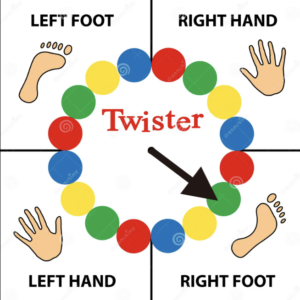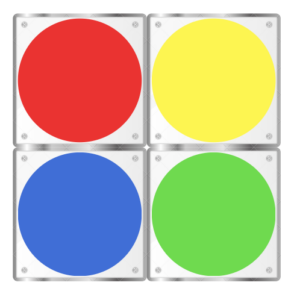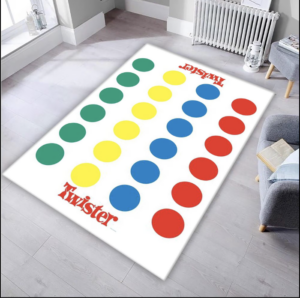Board games have always captured my interest, and for my final project, I’ve decided to reimagine the classic multiplayer game, Twister, by transforming it into an engaging solo experience. In this adapted version, I aim to introduce interactive elements, to enhance the traditional Twister setup.
Game Components:
In the standard version of the game, participants spin a wheel to determine a color and a designated body part (hands or feet). Subsequently, players must position the indicated body part onto the corresponding colored circle on the Twister mat. The objective is to avoid losing balance, and if the player falls down, they lose. For the physical setup in my version, I plan to craft the Twister mat using acrylic sheets. Under each colored circle, I will integrate force sensors to detect whether a player has placed their palm or foot on the designated spot. This modification eliminates the need for multiple players while retaining the essence of the original game.

Digital Interface with p5js:
Utilizing the p5js interface, I intend to create a virtual spinner that dictates the next move for the player. p5js will not only control the wheel spinning but also manage the game score and determine win/loss conditions and the start & end of the game.
Additional Gameplay Elements:
To introduce a new challenge, I plan to incorporate ultrasonic sensors. In the classic game there is one option on the wheel that if landed on, the users have to keep their body part in the air. In this version, When the wheel lands on a specific option, players must extend their hands or feet to a particular distance, as detected by the sensors.
Wheel Spinning Mechanism: Considering the physical nature of the game that actively uses the player’s hands, I’m exploring two potential options for spinning the wheel through p5js instead of directly clicking it on the laptop. One approach involves a switch on the Twister mat that, when pressed, triggers the p5js interface to spin the wheel. Alternatively, I’m considering a voice-activated mechanism where saying the word ‘spin’ initiates the wheel rotation.

Arduino Circuit: The Arduino circuit will be straightforward, connecting switches and force sensors to the Twister mat. However, I’m intrigued by the possibility of incorporating flex sensors/motors to introduce more complexity and fun to the game. These additions could potentially respond to the player’s movements, making the experience even more interactive.
Considerations:
While developing the game, I recognize the need to redefine the losing condition for a single-player setup. Unlike the traditional game where a player falls to signify defeat, I aim to explore alternative practical criteria that maintain the challenge and excitement without relying on physical falls in a solo context. By combining physical and digital elements, along with creative twists to the gameplay, I hope to transform Twister into a captivating and entertaining game experience.

